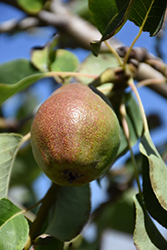It's all about ...
plants

Cold Snap™ Pear
Pyrus communis 'Cold Snap'
Height: 10 feet
Spread: 20 feet
Sunlight:
![]()
Hardiness Zone: 5a
Other Names: Common Pear
Brand: J.C. Bakker & Sons Ltd.
Description:
An exceptional selection which produces crisp, sweet, juicy pears with a long storage life; very showy white flowers in spring on an upright, spreading habit; needs a pollinator; highly resistant to disease; fallen fruit can be messy
Edible Qualities
Cold Snap™ Pear is a small tree that is typically grown for its edible qualities. It produces light green oblong pears (which are botanically known as 'pomes') with a brick red blush and white flesh which are usually ready for picking in early fall. The pears have a sweet taste and a juicy texture.
The pears are most often used in the following ways:
- Fresh Eating
- Cooking
- Baking
- Juice-Making
- Canning
Features & Attributes
Cold Snap™ Pear is bathed in stunning clusters of white flowers along the branches in early spring. It has forest green deciduous foliage. The glossy pointy leaves turn an outstanding deep purple in the fall. The fruits are showy light green pears with a brick red blush, which are carried in abundance in early fall. The fruit can be messy if allowed to drop on the lawn or walkways, and may require occasional clean-up.
This is a dense deciduous tree with an upright spreading habit of growth. Its average texture blends into the landscape, but can be balanced by one or two finer or coarser trees or shrubs for an effective composition. This is a high maintenance plant that will require regular care and upkeep, and is best pruned in late winter once the threat of extreme cold has passed. Gardeners should be aware of the following characteristic(s) that may warrant special consideration;
- Messy
- Disease
Aside from its primary use as an edible, Cold Snap™ Pear is sutiable for the following landscape applications;
- Accent
- Orchard/Edible Landscaping
Planting & Growing
Cold Snap™ Pear will grow to be about 10 feet tall at maturity, with a spread of 20 feet. It has a low canopy with a typical clearance of 2 feet from the ground, and is suitable for planting under power lines. It grows at a fast rate, and under ideal conditions can be expected to live for 50 years or more. This variety requires a different selection of the same species growing nearby in order to set fruit.
This tree is typically grown in a designated area of the yard because of its mature size and spread. It should only be grown in full sunlight. It does best in average to evenly moist conditions, but will not tolerate standing water. It is not particular as to soil type or pH. It is highly tolerant of urban pollution and will even thrive in inner city environments. This is a selected variety of a species not originally from North America.
This plant is not reliably hardy in our region, and certain restrictions may apply; contact the store for more information.
